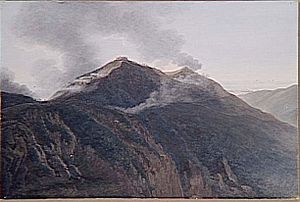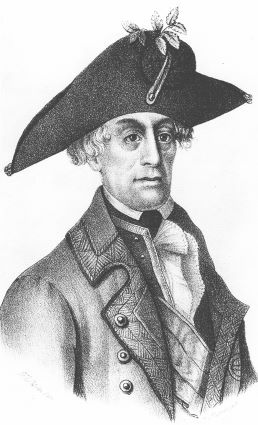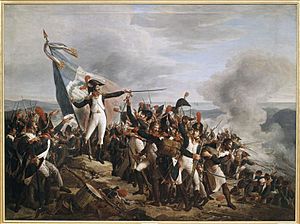Battle of Montenotte facts for kids
Quick facts for kids Battle of Montenotte |
|||||||
|---|---|---|---|---|---|---|---|
| Part of the French Revolutionary War | |||||||
 Attack on the redoubt of Monte-Legino by Giuseppe Pietro Bagetti (1764-1831) |
|||||||
|
|||||||
| Belligerents | |||||||
| Commanders and leaders | |||||||
| Strength | |||||||
| 9,000, 18 guns | 6,000, 12 guns | ||||||
| Casualties and losses | |||||||
| ~200 | 3,500 12 guns |
||||||
The Battle of Montenotte was a key battle during the French Revolutionary Wars. It took place on April 12, 1796. The battle was fought between the French army, led by a young General Napoleon Bonaparte, and Austrian forces under Count Eugène-Guillaume Argenteau. The French won this important battle. It happened near the village of Cairo Montenotte in what was then the Kingdom of Piedmont-Sardinia. Today, this area is in northwestern Italy.
On April 11, Argenteau's troops attacked a French fort on a mountaintop. They tried several times but could not capture it. By the next morning, Napoleon had gathered many more French soldiers. They attacked Argenteau's outnumbered forces. The main French attack came from the mountaintop fort. Another French force attacked the weak right side of the Austrian army, overwhelming them. Argenteau's troops had to retreat quickly. They lost many soldiers and became very disorganized. This battle was important because it threatened to cut off the connection between the Austrian and Sardinian armies. It was part of the larger Montenotte Campaign.
Contents
Background to the Battle
On March 27, 1796, a young general named Napoleon Bonaparte arrived in Nice. He was there to take command of the French Army of Italy. This was his first time leading an entire army. His army had about 63,000 soldiers. However, only about 37,600 men and 60 cannons were ready for battle. The soldiers were not well-fed. They were also months behind on their pay and had poor equipment. Because of this, many units had low spirits, and some even rebelled.
Napoleon's main opponent was the Austrian general Johann Peter Beaulieu. Beaulieu was also new to fighting in Italy. He commanded about 19,500 Austrian soldiers. Half of these were still in their winter camps. Another 11,500 Austrians, led by Argenteau, were spread out further west. The Kingdom of Sardinia-Piedmont army had about 20,000 men. They were positioned west of Argenteau's troops.
Napoleon planned to move from the coast. He wanted to drive a wedge between Beaulieu's Austrian army and the Sardinian army. The Sardinian army was led by Michelangelo Alessandro Colli-Marchi. Colli was an Austrian officer helping the Sardinian army. He was friends with Beaulieu. However, the Austrian government secretly told Beaulieu not to trust his Sardinian ally. This made it hard for the two allied leaders to agree on a plan. Colli worried about an attack that would split their armies. This was exactly what Napoleon was planning. Colli wanted their armies to gather in the middle. But Beaulieu thought the French wanted to capture Genoa. He decided to attack to stop that.
On April 10, the left side of the Austrian army attacked a French brigade. This happened in the Battle of Voltri. The French commander, General Jean-Baptiste Cervoni, fought well. He managed to retreat safely to Savona along the coast. Beaulieu then realized he was dangerously far from Argenteau's forces. He decided to move his left wing west to help Argenteau. He also ordered more troops from Lombardy to gather.
The roads around the Montenotte battlefield looked like a triangle. The village of Altare was at the bottom left. It was on the main road from Savona to Ceva. Altare was also on the important Cadibona Pass road. The village of Madonna di Savona was at the bottom right. Montenotte Superiore was at the top of the triangle. From there, the road went north to Montenotte Inferiore. Three hills were along the right side of the triangle. These were Monte San Giorgio, Monte Pra, and Monte Negino (or Monte Legino).
The Battle Unfolds
Fighting at Monte Negino
Argenteau's attack started on April 11. The Austrians, with 3,700 soldiers, moved against a French position on Monte Negino. Argenteau led some of his troops to Montenotte Superiore. There, he met with General Mathias Rukavina von Boynograd and his soldiers.
The Austrians began to push southeast. They drove back the French outposts on Monte San Giorgio and Monte Pra. About 1,000 French soldiers, led by Colonel Henri-François Fornésy, held an old fort on Monte Negino. Colonel Antoine-Guillaume Rampon arrived and took command. More French soldiers also came to help.
The road to Monte Negino followed the top of the Apennine mountains. Austrian soldiers, including Croats, attacked. At one point, the French soldiers seemed to be losing heart. But Rampon encouraged them. He made them promise to "conquer or die." All the Austrian attacks failed. General Rukavina was shot in the shoulder. Argenteau stopped the fighting around 4:00 PM. That evening, Argenteau asked for more soldiers. The French estimated Austrian losses at 200 to 300, but they were likely closer to 100. The French reported 57 casualties.
The Main Battle at Montenotte
Argenteau's attack made Napoleon act quickly. Napoleon moved two divisions, led by General André Masséna, from Savona. They went to the area of the Cadibona Pass. Napoleon was sure that Beaulieu was too far east to help Argenteau. So, he decided to crush Argenteau's forces. He ordered General Amédée Emmanuel Francois Laharpe's division to join Rampon's troops. This made a total of 7,000 soldiers at Monte Negino. Masséna marched from Altare with 4,000 men. To get into position, the troops started marching at 2:00 AM in a rainstorm.
A small Austrian force marched all night to reach Montenotte by morning. Argenteau used these soldiers to guard the Altare road. The rest of his Austrians still faced Monte Negino.
A thick fog covered the area at dawn on April 12. When the fog cleared, French cannons on Monte Negino began firing. Argenteau saw that he was facing a very large French army. Soon after, Masséna's soldiers attacked the weak right side of the Austrian army. They overwhelmed the defenders with their greater numbers. Argenteau tried to hold the center and left flank. But Masséna's attack was so fast that Argenteau ordered a retreat. Many Austrian soldiers were lost or captured. The battle was over by 9:30 AM.
Results of the Battle
The Battle of Montenotte was General Bonaparte's first victory in the Montenotte Campaign. By the next morning, Argenteau reported that only 700 of his men were still with their units. The rest were either killed, wounded, or scattered. French losses were light, with only about 200 casualties. The Austrians reported 696 losses, including killed, wounded, and missing. However, some historians say the losses were much higher. They suggest the Austrians lost around 2,500 men and 12 cannons. Most of these Austrian losses were soldiers taken prisoner.
A very shaken Argenteau pulled his remaining soldiers back. They went to protect Acqui Terme. Other Austrian forces held Dego, which was about 7.5 kilometers (4.7 miles) northwest of Montenotte Superiore. Argenteau sent an urgent message to Beaulieu. He said his command was "almost completely destroyed." Napoleon then ordered his army to push forward. He wanted to make the gap between the Austrian and Sardinian armies even wider. He planned to move west toward Millesimo and north toward Dego. The next battles were the Battle of Millesimo on April 13 and the Second Battle of Dego on April 14 and 15.
Images for kids
See also
 In Spanish: Batalla de Montenotte para niños
In Spanish: Batalla de Montenotte para niños
- Montenotte Campaign
- Battle of Voltri, 10 April 1796
- Battle of Millesimo, 13 April 1796
- Second Battle of Dego, 14–15 April 1796
- Battle of Ceva, 16 April 1796
- Battle of Mondovì, 21 April 1796





